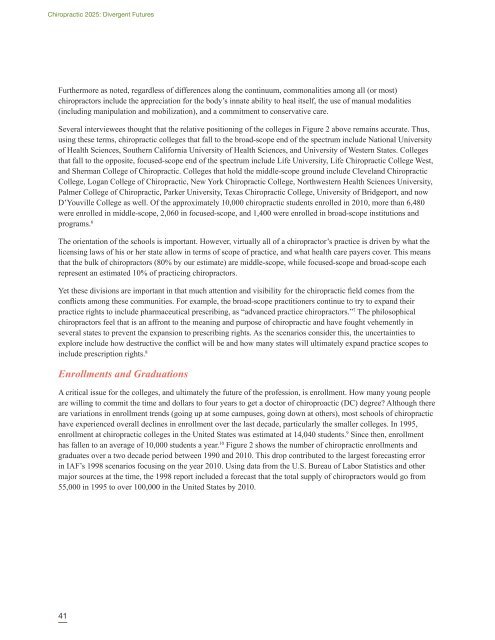Chiropractic 2025:
Chiropractic 2025:
Chiropractic 2025:
You also want an ePaper? Increase the reach of your titles
YUMPU automatically turns print PDFs into web optimized ePapers that Google loves.
<strong>Chiropractic</strong> <strong>2025</strong>: Divergent Futures<br />
Furthermore as noted, regardless of differences along the continuum, commonalities among all (or most)<br />
chiropractors include the appreciation for the body’s innate ability to heal itself, the use of manual modalities<br />
(including manipulation and mobilization), and a commitment to conservative care.<br />
Several interviewees thought that the relative positioning of the colleges in Figure 2 above remains accurate. Thus,<br />
using these terms, chiropractic colleges that fall to the broad-scope end of the spectrum include National University<br />
of Health Sciences, Southern California University of Health Sciences, and University of Western States. Colleges<br />
that fall to the opposite, focused-scope end of the spectrum include Life University, Life <strong>Chiropractic</strong> College West,<br />
and Sherman College of <strong>Chiropractic</strong>. Colleges that hold the middle-scope ground include Cleveland <strong>Chiropractic</strong><br />
College, Logan College of <strong>Chiropractic</strong>, New York <strong>Chiropractic</strong> College, Northwestern Health Sciences University,<br />
Palmer College of <strong>Chiropractic</strong>, Parker University, Texas <strong>Chiropractic</strong> College, University of Bridgeport, and now<br />
D’Youville College as well. Of the approximately 10,000 chiropractic students enrolled in 2010, more than 6,480<br />
were enrolled in middle-scope, 2,060 in focused-scope, and 1,400 were enrolled in broad-scope institutions and<br />
programs. 6<br />
The orientation of the schools is important. However, virtually all of a chiropractor’s practice is driven by what the<br />
licensing laws of his or her state allow in terms of scope of practice, and what health care payers cover. This means<br />
that the bulk of chiropractors (80% by our estimate) are middle-scope, while focused-scope and broad-scope each<br />
represent an estimated 10% of practicing chiropractors.<br />
Yet these divisions are important in that much attention and visibility for the chiropractic field comes from the<br />
conflicts among these communities. For example, the broad-scope practitioners continue to try to expand their<br />
practice rights to include pharmaceutical prescribing, as “advanced practice chiropractors.” 7 The philosophical<br />
chiropractors feel that is an affront to the meaning and purpose of chiropractic and have fought vehemently in<br />
several states to prevent the expansion to prescribing rights. As the scenarios consider this, the uncertainties to<br />
explore include how destructive the conflict will be and how many states will ultimately expand practice scopes to<br />
include prescription rights. 8<br />
Enrollments and Graduations<br />
A critical issue for the colleges, and ultimately the future of the profession, is enrollment. How many young people<br />
are willing to commit the time and dollars to four years to get a doctor of chiroproactic (DC) degree? Although there<br />
are variations in enrollment trends (going up at some campuses, going down at others), most schools of chiropractic<br />
have experienced overall declines in enrollment over the last decade, particularly the smaller colleges. In 1995,<br />
enrollment at chiropractic colleges in the United States was estimated at 14,040 students. 9 Since then, enrollment<br />
has fallen to an average of 10,000 students a year. 10 Figure 2 shows the number of chiropractic enrollments and<br />
graduates over a two decade period between 1990 and 2010. This drop contributed to the largest forecasting error<br />
in IAF’s 1998 scenarios focusing on the year 2010. Using data from the U.S. Bureau of Labor Statistics and other<br />
major sources at the time, the 1998 report included a forecast that the total supply of chiropractors would go from<br />
55,000 in 1995 to over 100,000 in the United States by 2010.<br />
41


